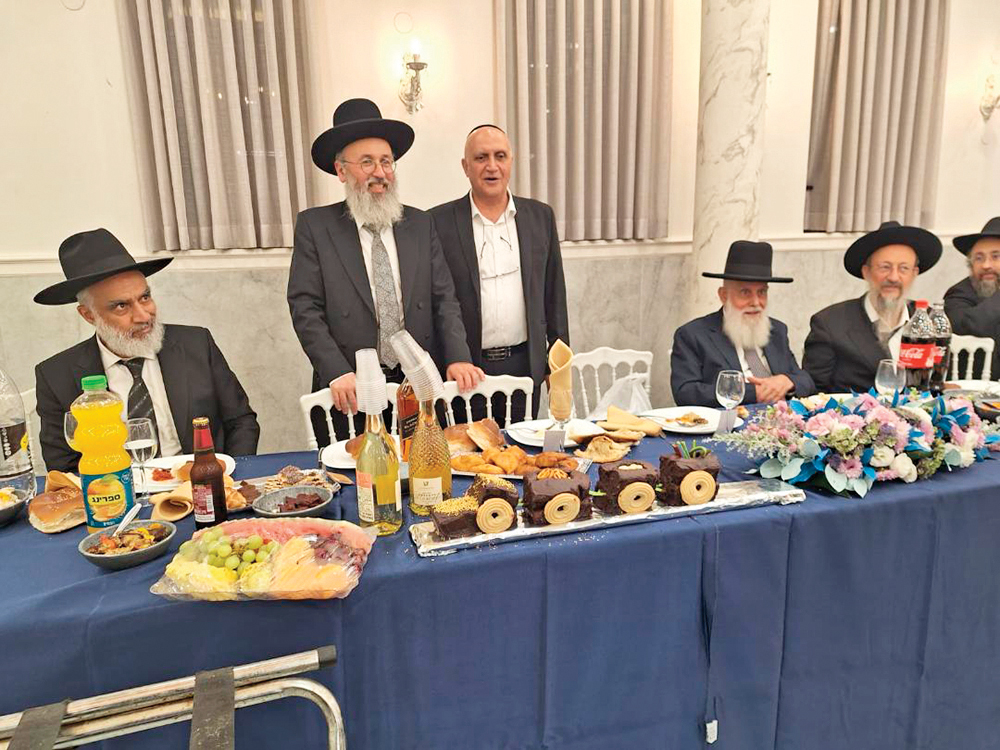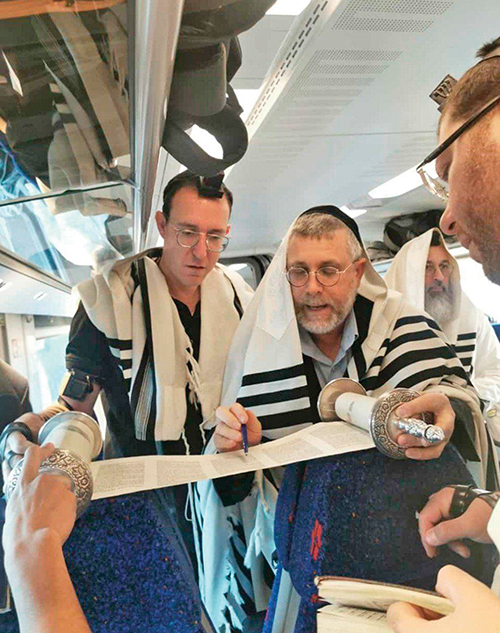
Rav Efraim Bograd seated second from the left. (Credit: Dr. Hillel Steiner, with thanks to Yair Rappaport)
In Israel, the pervasiveness of minyanim means it’s less likely that you have to find a minyan and more likely that a minyan will find you. Baruch Hashem, they are everywhere—in hotels and office buildings, hospitals and theater lobbies, in the middle of the desert and, of course, on commuter trains.
Six years ago, Rav Benziyon Tufik of Ramot, Jerusalem, was ordained as a dayan at the Haifa Rabbinical Court. Providentially, only a month earlier, the Israel Train System added a train that traveled to Tel Aviv from Jerusalem. (It had previously gone only as far as Ben Gurion Airport.) Rav Tufik started taking the 6:39 a.m. train, then changing trains in Tel Aviv to continue his journey to Haifa.
Rav Tufik wanted to pray Shacharit on the train, and began going from commuter to commuter asking if they wanted to make a minyan. Soon, a regular minyan formed on the train. Today there are 50-60 worshippers on a daily basis, plus a few women who pray in the “women’s section” on the second floor of the train. Because not everyone has the same daily schedule, the congregants rotate so that there are really hundreds of people who pray in this minyan at different times. It even has its own Whatsapp group. Rav Tufik isn’t on it because he has a kosher phone, but he issues notices and gives instructions to be posted.
At the beginning, the 6:39 a.m. minyan didn’t have a sefer Torah but the train from Tel Aviv did, so Rav Tufik would hear the Torah reading on the second leg of his journey. But soon a friend of his, Rav Efraim Bograd, volunteered a small sefer Torah to be used on the Jerusalem train.
This of course presents a logistical problem of what to do with the sefer Torah after the commute; but various members of the minyan take the Torah and keep it safe on days the Torah isn’t read. For example, Dr. Hillel Steiner, who has been a member of the moving minyan for four and a half years, sometimes takes the Torah and puts it in the synagogue at Wolfson Hospital, where he works.

(Credit: Dr. Hillel Steiner, with thanks to Yair Rappaport)
Rav Tufik makes sure that the Torah is on the train even on days where the Rabbanut is on hiatus. The second train that Rav Tufik takes no longer has a sefer Torah. So when it’s Rav Tufik’s turn to take the Torah after the minyan, he brings it back on his way home for Mincha and reads it during the Mincha minyan for the people who hadn’t heard it that morning. This is especially relevant for people boarding the train at Ben Gurion Airport, who were airborne during Shacharit and didn’t have a chance to hear the Torah reading.
Rav Bograd was worried that the sefer Torah could get ruined if it rained or snowed. A colleague of Dr. Steiner’s who had served in the Israeli navy found a solution. He knew that the navy uses special bags to protect electronic equipment from moisture, and he found a store that sells these bags. Now when it rains or snows, the Torah is kept sealed and protected in the insulated navy bag.
As the minyan grew and became steady, the last car of the train was designated for the minyan to avoid disturbing other commuters. The minyan starts about 10-15 minutes before departure (depending on if the Torah is read that day) so that it is already organized and involved in praying when the train comes. Dr. Steiner says that in this case, they’re not running for the train, they’re running for the minyan!
For Steiner, whose father passed away during Covid, a regular minyan was important and the regular minyan on the train helped him fulfill his obligations for saying Kaddish. Aside from the regular group of participants, the minyan is sometimes joined by one-timers and since October 7, many more soldiers than usual have come aboard. The minyan also makes siyumim, complete with food and drinks.
One day, on the second train, Rav Tufik heard there was going to be a siyum. He expected it to be on Gemara but it ended up being a siyum Mishnayot hosted by Albert Gedanian, who lives in Holon but travels by train every day to his clothing store in Nahariya. Rav Tufik was inspired to start a chavruta with Gedanian and this past Tammuz and they made a siyum on all the shisha sidrei Mishna. Rav Tufik made a huge celebration, akin to a bar mitzvah, complete with a cake in the shape of a train and many rabbis in attendance.
Now the chavruta has started learning Gemara together. Because Rav Tufik learns with enthusiasm, which translates into learning loudly, he and Gedanian have found a small isolated table on the train. But when they hear the learning, many people come over to join them. Some of them are young men who used to learn at yeshiva. Gedanian also bought tefillin and a tallit, which he offers to soldiers he meets. One day after the big siyum, a man sat down beside Gedanian on the train and he began learning. Gedanian politely asked whether he could join him. Since Gedanian does not look like a typical ben Torah, the man looked at him rather disdainfully and asked what connection he had with learning. Gedanian answered, “What do you mean? I just made a siyum on all the tractates of the Mishna!” The man’s face lit up. “You’re the guy from the train who just made a siyum?” He had read an article about the train siyum and of course his attitude toward the celebrity of that siyum changed immediately.
Since the 6:39 a.m. train minyan is a mix of people of all ethnicities, ages and cultures, the participants have developed their own customs so that everyone feels comfortable. Dr. Steiner praises Rav Tufik as a paragon of ben adam laMakom and ben adam l’chavero. Most dayanim are sent to outlying, less central cities at the start of their career, and Rav Tufik has been hoping to get a post in Jerusalem or at least nearer to his home. When that happens, his minyan will probably go on without him under the direction of Dr. Steiner and other loyal members, who will continue this Kiddush Hashem, which is no less than a modern day miracle of a minyan on a cross-country Israeli train.
Rosally Saltsman is a freelance writer, originally from Montreal, who lives in Israel. Come join her!








